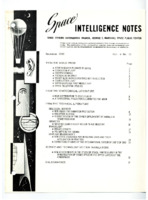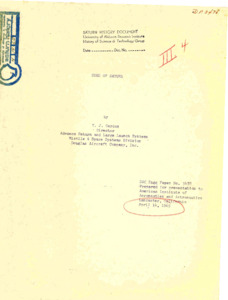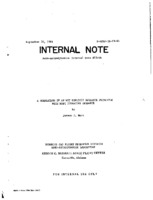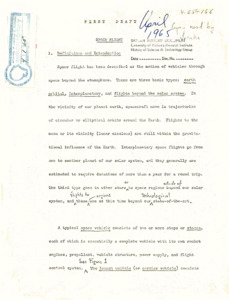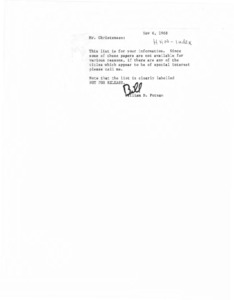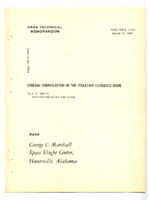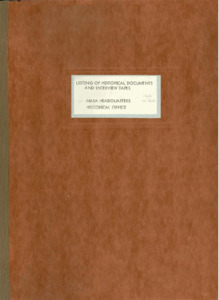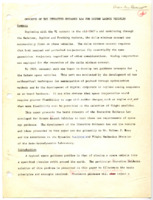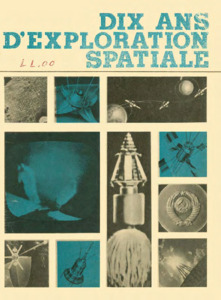
Browse Items (132 total)
Sort by:
-
Space Intelligence Notes, December 1963.
This is Vol. 4, No. 12 of Space Intelligence Notes, a publication of the Space Systems Information Branch at the Marshall Space Flight Center. According to the table of contents page, topics include various articles from the world press such as planned atomic research in Israel, the flight of Cosmos-21 and Cosmos-22, and the launch of Japan's first missile ship; from the semitechnical literature such as new constributions to space flight; from the technical literature includng biological sciences, chemistry, space flight, and units and measurements; science and technology section translations; and bibliographies. -
"Uses of Saturn."
Saturn and Apollo hardware will not have realized their ultimate potential for space exploration after the project lunar landing is complete. To accomplish the Apollo lunar landing program, an immense backlog of technology, facilities, and booster capability will have been built up, and we believe proper utilization of this resource will fill the needs for planetary, lunar and earth orbital space exploration for years to come. -
"A Comparison of an MIT Explicit Guidance Principle with MSFC Iterative Guidance."
From the summary: "Both [guidance] schemes steer toward a specified end point. The MIT scheme uses thrust to cancel out the effective gravity, a nonlinear term, which may be inefficient in certain cases. The MSFC scheme is more closely connected with calculus of variations and optimization theory in a reasonable degree of approximation." -
"Space flight : first draft."
Appears to be a rough dfraft with editorial comments and revision notes. Includes references to figures and tables.; Page 31 is missing. Pages 37 through 44 do not exist; there is a note about this on page 36. Page 67 also does not exist. -
Oral History Interview With Robert McBrayer
After Robert McBrayer graduated college, he reported to the Johnson Space Center in March of 1963. He was there assigned to a section called "Biodynamics" and in that section, they worked on Human tolerances to impact sustaining acceleration and acoustics. Robert was assigned to the acoustics group, and his first job was to design and develop a machine to produce low-frequency pure tones to test humans. He also designed and developed a test chamber for testing humans, and he participated in doing the actual human test with the machines that he helped build. He helped document the results as well. After his venture in doing basic research, he went into an area called "crew's survival equipment design and development," and he was assigned pieces of equipment that were his to design, update, and help build. In 1966, Robert asked to be transferred from the Johnson Space Center to the Marshall Space Flight Center, and he then moved to Huntsville, AL. Robert was immediately put on the Orbital Workshop where they were writing task analysis, and procedures for crew station reviews. They did two of those, on in 1967 and the other in 1968. From the Orbital Workshop, he was responsible for all the crew interfaces on adapter, etc.Tags Oral History -
"Master list of projects."
Note attached to document to Mr. Christensen from William D. Putnam. List of projects ordered by criteria. -
"General Formulation of the Iterative Guidance Mode."
From the abstract: "This report discusses the iterative guidance mode and its application to three-dimensional upper stage vacuum flight. It is an inertial or closed system mode in that the only inputs required after liftoff are available from the onboard navigation system. That is, the iterative scheme computes steering commands as a function of the state and of the vehicle - velocity, position, longitudinal acceleration, and gravitational acceleration - and the desired cutoff conditions. The guidance commands are updated each guidance cycle, using the updated state of the vehicle. The iterative guidance scheme is a path adaptive guidance scheme in that it will retain its optimization properties under all expected types and magnitudes of vehicle perturbations without any loss in accuracy at liftoff." -
"Listing of Historical Documents and Interview Tapes."
Archive copy is a poor photocopy.; Handwritten on the first page is "10/25/67".; Includes a letter dated Nov. 6, 1968 to Mr. Christensen from William D. Putnam. -
Draft of "Concepts of the Iterative Guidance Law for Saturn Launch Vehicles."
The summary notes, "In 1960, research work was begun to develop new guidance concepts for the Saturn space vehicles. [...] This paper presents the basics of the Iterative Guidance Law developed for Saturn launch vehicles to meet these new requirements of space age guidance. The development of the Iterative Guidance Law and the results and ideas presented in this paper are due primarily to Mr. Helmut J. Horn and his associates in the Dynamics Analysis and Flight Mechanics Division of the Aero-Astrodynamics Laboratory." Marked "Research Review, OK" in the upper right corner of the first page. The document includes corrections and additions to the text in red pencil. -
"Dix ans D'exploration Spatiale."
A series of french articles related to the space program.
